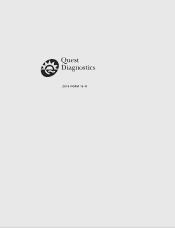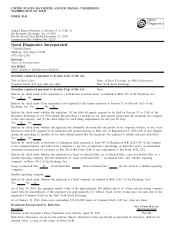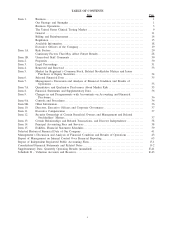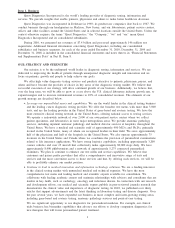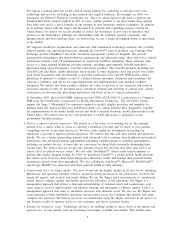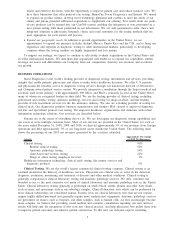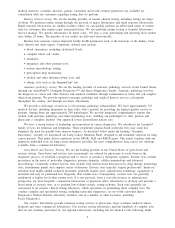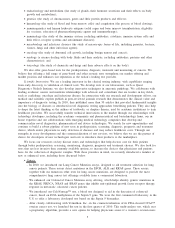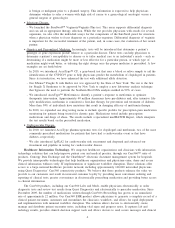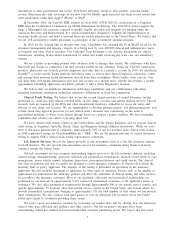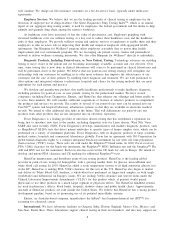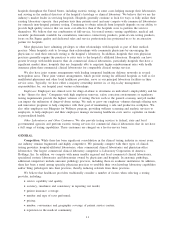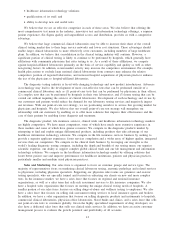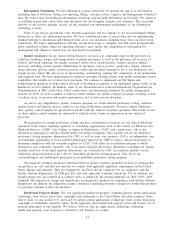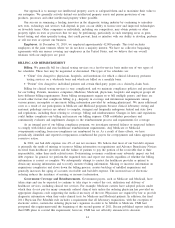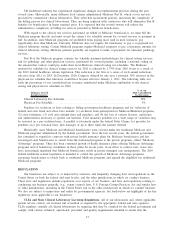Quest Diagnostics 2010 Annual Report Download - page 8
Download and view the complete annual report
Please find page 8 of the 2010 Quest Diagnostics annual report below. You can navigate through the pages in the report by either clicking on the pages listed below, or by using the keyword search tool below to find specific information within the annual report.
•endocrinology and metabolism (the study of glands, their hormone secretions and their effects on body
growth and metabolism);
•genetics (the study of chromosomes, genes and their protein products and effects);
•hematology (the study of blood and bone marrow cells) and coagulation (the process of blood clotting);
•immunogenetics and human leukocyte antigens (solid organ and bone marrow transplantation; eligibility
for vaccines; selection of pharmacotherapeutic agents and immunotherapy);
•immunology (the study of the immune system, including antibodies, cytokines, immune system cells and
their effect, receptor systems and autoimmune diseases);
•microbiology and infectious diseases (the study of microscopic forms of life, including parasites, bacteria,
viruses, fungi and other infectious agents);
•oncology (the study of abnormal cell growth, including benign tumors and cancer);
•serology (a science dealing with body fluids and their analysis, including antibodies, proteins and other
characteristics); and
•toxicology (the study of chemicals and drugs and their adverse effects on the body).
We also offer gene-based tests for the predisposition, diagnosis, treatment and monitoring of cancers. We
believe that offering a full range of gene-based and other esoteric tests strengthens our market offering and
market position and enhances our reputation as the nation’s leading test provider.
Scientific Innovation. We are a leading innovator in the clinical testing industry, with capabilities ranging
from early discovery to validation of clinical tests. We develop tests at our laboratories, such as Quest
Diagnostics Nichols Institute; we also develop innovative techniques in anatomic pathology. We collaborate with
leading academic centers and maintain relationships with advisors and consultants that are leaders in key fields,
such as cardiology, oncology and infectious disease. In connection with our research and development efforts, our
medical and scientific experts publish in peer-reviewed journals research that demonstrates the clinical value and
importance of diagnostic testing. In 2010, they published more than 30 articles that provided fundamental insights
into the biology of diseases or introduced novel diagnostic testing approaches benefitting patients. They also help
to shape the latest thinking as the authors of textbooks, or chapters therein, used by academic institutions to train
healthcare providers. We successfully transfer technical innovations to the market through our relationships with
technology developers, including the academic community and pharmaceutical and biotechnology firms, our in-
house expertise and our collaborations with emerging medical technology companies that develop and
commercialize novel diagnostics, pharmaceutical and device technologies. We search for new opportunities and
continue to build a robust pipeline of new tests in predisposition, screening, diagnosis, prognosis and treatment
choice, which assists physicians in early detection of diseases and may reduce healthcare costs. Through our
strengths in assay development and the commercialization of test services, we believe that we are the partner of
choice for developers of new technologies and tests to introduce their products to the marketplace.
We focus our resources on key disease states and technologies that help doctors care for their patients
through better predisposition, screening, monitoring, diagnosis, prognosis and treatment choices. We also look for
tests that are less invasive than currently available options, to increase the choices that physicians and patients
have for the collection of diagnostic samples. With these priorities in mind, we recently introduced a number of
new or enhanced tests, including those discussed below.
•Cancer.
- In 2010, we introduced our Lung Cancer Mutation assays, designed to aid treatment selection for lung
cancer patients. These assays detect mutations in the EFGR, ALK and KRAS genes. These assays,
together with our numerous other tests for lung cancer mutations, are designed to provide the most
comprehensive lung cancer test offerings available from a commercial laboratory.
- We enhanced our Colorectal Cancer Mutation assay offering, which helps identify genetic mutations in
the KRAS, PIK3CA, NRAS and BRAF genes that inhibit anti-epidermal growth factor receptor therapy
response in metastatic colorectal cancer patients.
- We introduced our ColoVantageTM test, a blood test designed to aid in the detection of colorectal
cancer, based on DNA methylation of the Septin 9 gene. We were the first commercial laboratory in the
U.S. to offer a laboratory developed test based on the Septin 9 biomarker.
- After closely collaborating with Vermillion, Inc. on the commericialization of its FDA-cleared OVA1TM
ovarian cancer test, we launched the test in the first quarter of 2010. This multi-analyte test, which uses
a proprietary algorithm, provides a new option for helping physicians assess if a woman’s ovarian mass
5

